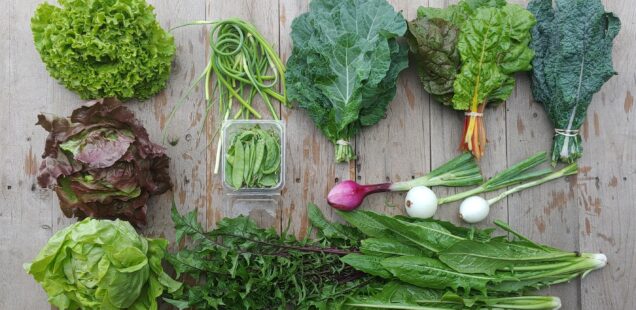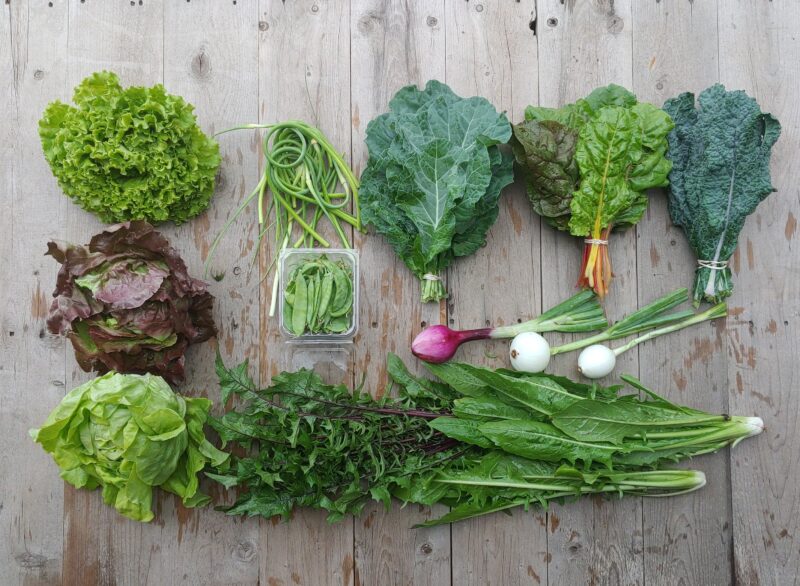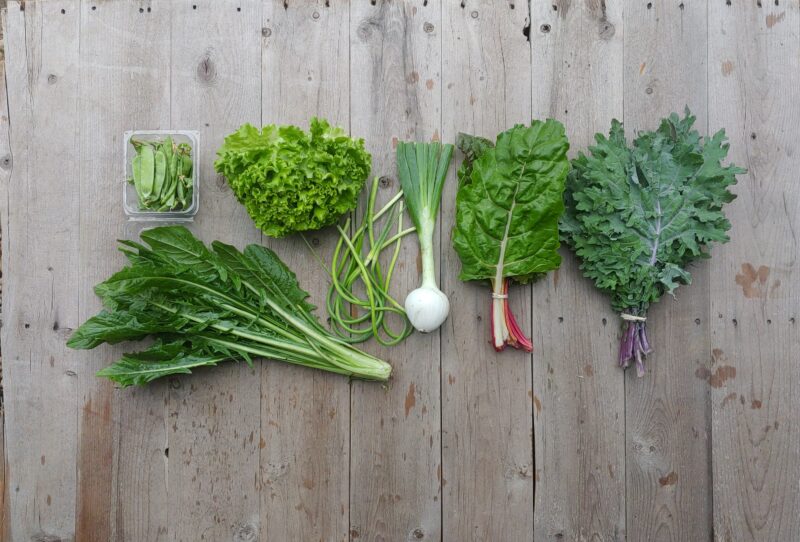
Share Notes May 11, 2023
CSA Share Notes:
Wow, you guys- this sudden heat and humidity is brutal. It was a challenge to get all the crops out of the field early enough in the morning on Tues and Wed before what we call “field heat” was too much for the harvest. You have to pick them before they’re wilting under the beating sun. We did it, and everything looked great when it went into the box. Reminder though: if the boxes sit on a warm porch for 6 hours, that’s beyond our limitations of control, so pick up as early as you are able. If you receive greens that look a bit wilted, remember our trick we taught you in the e-book: the Ice Cold Sink Plunge! Give them an hour or two in frigid water and they’ll be happy.
Our spring plants do not like extended periods of 90+ degree heat with 60+% humidity. If this heat stays, the spring crops will not continue to do well. So let’s hope this is a brief heat wave.
I think Justin and I both have a bit of PTSD from last year. Around mid April it cranked up into the 90s and didn’t cool down again until October. The lettuce burned up by early May and Spring season ended early. The summer crops suffered in excessive heat too (we got 5% expected yield out of our tomatoes).
So let me be real with you: we need your kindness and encouragement. This thing we do – growing crops in difficult conditions – is both wonderfully exciting and emotionally and physically exhausting. There is so little within our control in this line of work, and we’ve learned to function within those parameters, becoming more flexible and adaptable, but last year was our hardest growing year yet and it took a toll. We’ve done this a long time: 12 years in East Texas, 17 yrs in all. And walking into this heat wave after last year’s experience is worrisome. It’s not just that working in the heat has been rough (our bodies haven’t acclimated yet), but we’re already tired, already over-extended and behind from the difficult hiring season we’ve had (luckily 2 more farmhands start next week). And we would really like to see some cooler temperatures in the 10-day forecast. If you’re the type to send good vibes, pray, or meditate, give your farmers a bit of that loving time and attention as we work hard for you in the weeks to come. We’ll appreciate it.
Thanks for supporting our farm and letting us nourish your family!
Ok, so about this week’s box: it’s a very Greens-Heavy week. We do have lots of roots growing in the ground for you that are getting close but they aren’t ready yet. Consider it a personal challenge to use up every green this week (or find a friend to help you eat it)! Go back to our e-book and take a look at all the many many “exit strategies” we give you for getting all this food out of your fridge and into your belly. One of the best tips is to move your weekly meal-planning and grocery shopping day to AFTER you get your box so you know what you have to work with. You’ve got this!
Here’s this week’s vegetable line up.
- Garlic Scapes — NOT GREEN ONIONS! (I had some calls and emails about this) These are the flower bud stalks of the garlic plant. They grow out of the center of the plant stem and if we allowed them to, they would become a beautiful purple allium flower in another few weeks. But we don’t allow them to, because doing so would draw energy away from the root of the plant. And with garlic, we want to grow as big a root as possible! So we remove the scape and you get to enjoy this highly sought after treat. You can make them into a wonderful pesto, use them like green onions atop any dish for crunch and a mild garlic flavor, or try our quiche we served at a farm-to-table luncheon last summer. It’s got chard (you can sub any green) and lots of delicious goat cheese. Major crowd pleaser.
- Dandelion — Larges got 3, Regulars 2, and Minis 1. This is a very flavorful, highly nutritious green. All good food can be medicine, but this one definitely falls in the medicinal herb category. It’s super supportive and detoxing for both the liver and kidneys, loaded with vitamins A, C, and K, as well as folate (B9), calcium, and potassium. I’ll admit, this green is not my daily pick, but I manage to work it in every week because it’s so nutritious. This is an Italian cultivar so try it an Italian preparation. Go to google and search “Italian Dandelion Recipes” and you’ll have dozens of ideas! Or our method: use it with lettuce in a salad, 2 heads of lettuce to 1 dandelion. And dress it with plenty of fat and acid to cut the bitterness. We usually whip up an olive oil, lemon juice, and honey dressing. It’s fabulous sauteed down and topped with crumbled bacon, and again- some acid. Red wine vinegar would be my pick here.
- Spring Onion — 3, 2, 1. Everyone received Yellow, and Larges and Regulars also received a Red. All of it can be used, the bulb for chopping and cooking, the green as green onions. These are freshly dug and need to be refrigerated, as they are uncured.
- Head Lettuce – Again, 3 for the large shares, 2 for the regular shares, 1 for the minis. All shares received a frilly green summer crisp lettuce called Muir. The Regular and Large shares also received Skyphos, a gorgeous butterhead with dark red leaves with electric green centers (my favorite), and Larges all received an Adriana lettuce, a tender Boston type We process the lettuce very minimally, as it’s extremely delicate and we want it to reach you is as close to perfect condition as possible. This means you’ll need to wash it well.
- Snow Peas — For everybody this week. We used a pint of peas in a delicious Chinese stir fry Monday night with lots of garlic scapes, and locally grown Shitake mushrooms we scored at our Rose City Farmers Market.
- Carrots — Regular shares this week. Petite bunches of our rainbow carrot mix. These are coming along slower than we anticipated. We thought we’d be giving you quite a lot of carrots and beets by now, but they need a little more time. Hopefully in 2 more weeks we’ll be covered in root crops.
- Kale — Lacinato for Large shares, Winterbor (curly) Kale for Regulars, and Red Russian for Minis. These crops can be used interchangeably in any recipe that calls for kale. Red Russian is often a little more tender, so I prefer it for use in a raw salad. My weekly routine for greens is breakfast prep. I’m a daily hot-breakfast-eater (growing little kids and a breastfeeding mama need a lot of protein) but I need my mornings to go fast. So at the beginning of the week I cook up 1 lb of 1514 Breakfast sausage and a huge amount of greens (usually kale, sometimes collard or chard or spinach) with onion and garlic. I store this all in a large glass tupperware in the fridge and toss a a half cup into my egg scramble each morning for me and the girls. Sometimes we eat it as is, sometimes with salsa in tacos or on sourdough toast. This planning ahead step makes a fresh hot breakfast take me about 7 minutes each day. You can do this with any green we give you, and it’s delicious!
- Collard — A bunch of super tender fresh collards for the Large shares. If you’re not familiar with cooking collards, here’s our best tip: slice up an onion and chop a few cloves of garlic. Add a pinch of red pepper flakes if you’re daring and sauté (in bacon fat, even!) until translucent. Next toss in the torn or sliced collard leaves and wilt. Cook until as tender as you like them (I prefer mine with a little chew left). You can also sub collards into any Kale recipe with near identical result. It cooks down a LOT, so you might consider making one big batch of greens in this method with your kale, chard, dandelion, and collard. This would make a generous serving for +4 ppl if you got a large box.
- Chard — Large and Mini shares. This colorful crop is eye catching and tastes a whole lot like spinach. I enjoy it in a massaged-greens-salad (try it with cranberry, pecan, and parm, so good!) or cook it like any of my greens, usually with an animal fat (butter, ghee, lard, bacon grease) and garlic and onion. The stems are tasty too. The vitamins and minerals in the greens become more bio-available to your body when paired with a good amount of fat. (Isn’t nature genius? And it tastes good too!)
Veggie Storage tips:
You can always consult the e-book we sent you recently for a comprehensive veggie storage guide! Most everything will keep longest stored in the fridge sealed up in produce bags. All root crops should be removed from their tops to keep the roots from getting rubbery, and the greens stored separately, sealed up to stay fresh. Everything will need a gentle washing before cooking, but leave the dirt on until you’re ready to use them to prevent spoilage. Garlic scapes will want to be sealed up in an air-tight container in the fridge.
We’d love to hear stories and recipes of your culinary adventures this week. Tag us on Instagram or Facebook, showing us how you’ve used your CSA share.
Your farmers, Jess & Justin



Thank you!! I hope the heat holds off for y’all. May you find good help, too.
Cindy
Thanks, Cindy! We’ve got all farmhand positions nearly covered and are hitting our stride.
I made wilted dandelion green dish with raisins and it was great.
Oh, yummy!